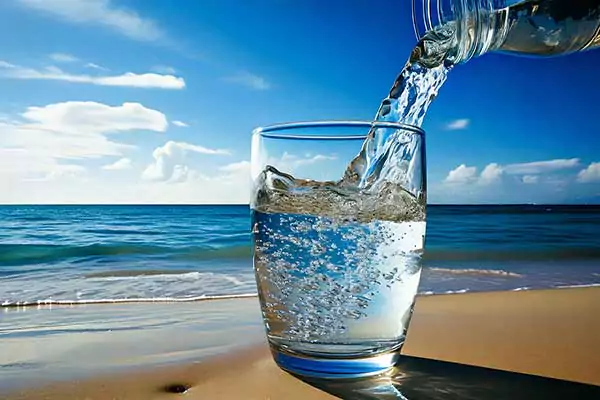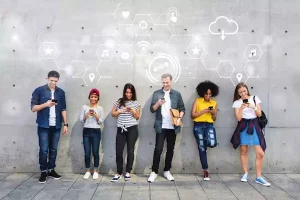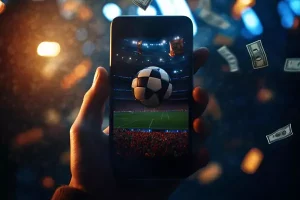Why don’t we get our drinking water from the ocean ?
- تاریخ 08/20/2025

فهرست مطالب
Is it possible to get drinking water from the ocean?
You’re stranded at sea and getting thirsty. Water fills the horizon—but you know you’re not supposed to drink it. So, what would actually happen to you if you did? And how can you find a way to hydrate?
The danger in drinking saltwater lies at the cellular level. To maintain their structural integrity, your body’s cells match the concentration of certain ions, like salt, within their membranes with the concentration outside of them—in your bloodstream, for instance.
Seawater is about four times saltier than your blood. So, when it’s ingested, the fluid outside your cells becomes much saltier. To relieve the resulting pressure difference, water flows out of your cells.
Your kidneys use this water to begin removing the excess salt—but they require much more freshwater to actually flush it all out. Consuming enough seawater without any freshwater can lead to salt poisoning.
The effects can be devastating as the body’s cells lose water and contract. This can cause tissues to shift and rupture and fluids to collect in critical organs. Overall, drinking seawater only makes things worse. Survival depends on finding—or creating—freshwater.
In the 4th century BCE, Greek philosopher Aristotle described two main modes of seawater desalination, which are still used today. One is thermal, and relies on heating seawater to yield vaporized condensed freshwater, a method ancient Greek sailors used regularly.
The other is reverse osmosis, which uses pressure to push seawater through a salt-filtering membrane—a process Aristotle documented with a sealed wax jar. In the intervening millennia, people continued using and innovating on these methods.
Making potable freshwater from seawater is a bigger project now than ever. Today, 2 billion people can’t access clean drinking water, and 87 different countries, including many currently considered “water rich,” are projected to be “water scarce” by 2050.
As of 2022, the world’s largest desalination plant turned over 2 billion liters of saltwater into drinkable freshwater every day using mostly thermal technology. But this method has drawbacks.
A lot of energy is required to generate the necessary heat, which is usually provided by fossil fuels. Thermal desalination plants also produce considerable waste in the form of brine—ultra-concentrated saltwater that can be harmful if simply returned to natural bodies of water.
Many see more promise in reverse osmosis, which nowadays uses synthetic membranes to filter out salt and other impurities. Overall, it’s more energy-efficient and less briny than thermal desalination.
As of 2020, around 17,000 desalination plants supplied more than 300 million people with freshwater, most of them using reverse osmosis. Those numbers are increasing. But waste, cost, efficiency, and sustainability remain big issues.
More research is needed to make renewable-powered desalination plants energy- and cost-effective at larger scales. Meanwhile, another body of water appears promising in combating water scarcity: wastewater.
Reverse osmosis membranes actually require less energy to remove contaminants and the small amounts of salt found in wastewater than they do to desalinate saltwater. And, importantly, wastewater recycling operations still yield pure, safe drinking water.
Okay, but back to the boat stranded at sea. First, a couple dehydration don’ts. Drinking your own urine isn’t recommended because a few days of filtering accumulating waste products without any freshwater relief can cause kidney damage.
And while it might feel counterintuitive, if you don’t have any freshwater to drink, it’s best not to eat—especially protein-rich food—because your body doesn’t have enough water to digest it without becoming more dehydrated.
You can, however, work to secure freshwater sources using any water-wicking materials you can find to help collect rain and dew. And you could get a low-tech thermal desalination operation going by letting seawater sunbake in containers and collecting the condensation.
You can also try getting some hydration by drinking bird and turtle blood and fish spinal fluid and eyes. Maybe that sounds unappealing—but desperate times might call for a collection of thirst-quenching measures.
چرا ما آب آشامیدنی خود را از اقیانوس تأمین نمیکنیم؟
شما در دریا گیر کردهاید و تشنهاید. آب تمام افق را پر کرده است—اما میدانید که نباید آن را بنوشید. پس، واقعاً اگر بخورید چه اتفاقی برایتان میافتد؟ و چگونه میتوانید خود را هیدراته نگه دارید؟
خطر نوشیدن آب شور در سطح سلولی است. برای حفظ ساختار سلولهای بدن، غشاهای سلولی غلظت برخی یونها، مثل نمک، را با غلظت خارج از سلول—مثلاً در جریان خون—متعادل نگه میدارند.
آب دریا تقریباً چهار برابر شورتر از خون شماست. وقتی آن را مینوشید، مایع خارج سلولها بسیار شورتر میشود. برای کاهش این اختلاف فشار، آب از سلولها خارج میشود.
کلیههای شما از این آب برای شروع دفع نمک اضافی استفاده میکنند—اما برای دفع کامل آن، به مقدار بسیار بیشتری آب تازه نیاز دارند. نوشیدن مقدار کافی آب دریا بدون آب شیرین میتواند منجر به مسمومیت با نمک شود.
اثرات آن میتواند ویرانگر باشد، زیرا سلولهای بدن آب خود را از دست داده و منقبض میشوند. این میتواند باعث جابهجایی و پارگی بافتها و تجمع مایعات در اندامهای حیاتی شود. بهطور کلی، نوشیدن آب دریا فقط وضعیت را بدتر میکند. بقا به پیدا کردن یا تولید آب تازه بستگی دارد.
در قرن چهارم قبل از میلاد، فیلسوف یونانی ارسطو دو روش اصلی شیرینسازی آب دریا را توضیح داد که هنوز هم استفاده میشوند. یکی از این روشها حرارتی است و با گرم کردن آب دریا، بخار آب تولید میکند و سپس آن را جمعآوری کرده و به آب شیرین تبدیل میکند—روشی که دریانوردان یونان باستان بهطور منظم استفاده میکردند.
روش دیگر اسمز معکوس است که با فشار آب دریا را از غشای فیلتر نمک عبور میدهد—فرآیندی که ارسطو آن را با یک ظرف مومی مهر و موم شده ثبت کرده بود. در طول هزاران سال بعد، مردم به استفاده و نوآوری در این روشها ادامه دادند.
امروزه تولید آب آشامیدنی از آب دریا پروژهای بزرگتر از همیشه است. در حال حاضر، ۲ میلیارد نفر به آب آشامیدنی سالم دسترسی ندارند و پیشبینی میشود تا سال ۲۰۵۰، ۸۷ کشور—از جمله بسیاری که اکنون «پرجو» در نظر گرفته میشوند—با کمبود آب مواجه شوند.
تا سال ۲۰۲۲، بزرگترین کارخانه شیرینسازی آب در جهان، روزانه بیش از ۲ میلیارد لیتر آب دریا را با استفاده از فناوری حرارتی به آب آشامیدنی تبدیل میکرد. اما این روش معایبی دارد.
تولید گرمای لازم برای این فرآیند انرژی زیادی میطلبد که معمولاً از سوختهای فسیلی تأمین میشود. همچنین کارخانههای حرارتی مقدار قابل توجهی پساب شور (آب فوقالعاده نمکدار) تولید میکنند که اگر مستقیماً به منابع طبیعی بازگردانده شود، میتواند مضر باشد.
بسیاری امید بیشتری به روش اسمز معکوس دارند، که امروزه با غشاهای مصنوعی برای فیلتر کردن نمک و دیگر ناخالصیها استفاده میشود. بهطور کلی، این روش بهینهتر و کمنمکتر از شیرینسازی حرارتی است.
تا سال ۲۰۲۰، حدود ۱۷ هزار کارخانه شیرینسازی آب بیش از ۳۰۰ میلیون نفر را با آب آشامیدنی تأمین کردند که بیشتر آنها از اسمز معکوس استفاده میکردند. این تعداد همچنان در حال افزایش است، اما مسائل مربوط به پساب، هزینه، بازده و پایداری همچنان چالشبرانگیز باقی ماندهاند.
تحقیقات بیشتری لازم است تا کارخانههای شیرینسازی آب با انرژیهای تجدیدپذیر در مقیاس بزرگ، اقتصادی و بهینه شوند. در همین حال، منبع دیگری از آب میتواند در مقابله با کمبود آب مفید باشد: فاضلاب.
غشاهای اسمز معکوس در واقع انرژی کمتری برای حذف آلایندهها و مقادیر اندک نمک موجود در فاضلاب نسبت به آب دریا نیاز دارند. و مهمتر اینکه، بازیافت فاضلاب هنوز میتواند آب خالص و ایمن برای آشامیدن تولید کند.
حالا برگردیم به قایق گیر کرده در دریا. اول چند نکته در مورد کمآبی بدن. نوشیدن ادرار خودتان توصیه نمیشود، زیرا چند روز تصفیه مواد زائد تجمعیافته بدون آب تازه میتواند به کلیهها آسیب بزند.
و اگرچه ممکن است غیرمنطقی به نظر برسد، اگر آب تازه برای نوشیدن ندارید، بهتر است غذا نخورید—بهویژه غذاهای پرپروتئین—چون بدن شما آب کافی برای هضم آنها ندارد و در نتیجه بیشتر کمآب میشود.
با این حال، میتوانید با استفاده از هر ماده جاذب آب که پیدا میکنید، آب باران و شبنم را جمعآوری کنید. همچنین میتوانید یک روش ساده حرارتی راه بیندازید، مثلاً آب دریا را در ظروف زیر آفتاب قرار دهید و بخار جمعشده را جمعآوری کنید.
همچنین میتوانید مقداری آب از خون پرندگان و لاکپشتها و مایعات نخاع و چشم ماهیها به دست بیاورید. شاید این روشها خوشایند به نظر نرسند—اما در شرایط اضطراری، گاهی لازم است از هر روشی برای رفع تشنگی استفاده شود.
شما همچنین ممکن است دوست داشته باشید

connect with people

? What is bipolar disorder

